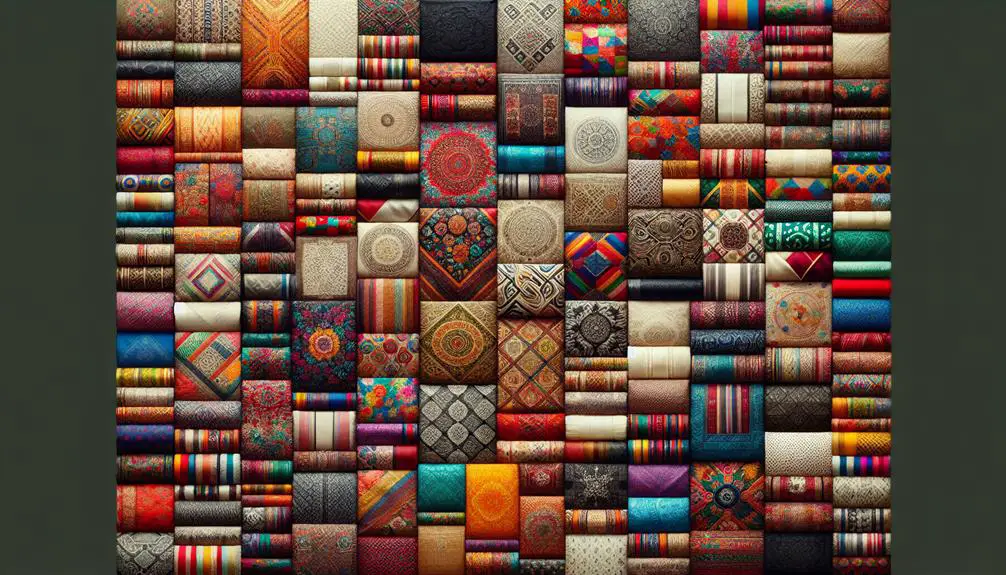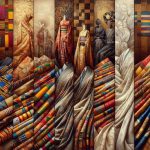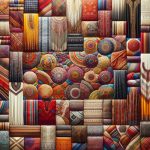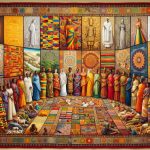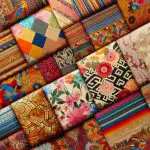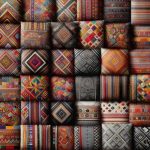You might think traditional fabrics are just old-fashioned textiles, but they're actually vibrant threads of cultural heritage. Imagine the intricate Indian silk saris, the bold patterns of African Kente cloth, or the refined elegance of Japanese kimono fabrics. Each piece isn't merely clothing; it's a canvas of history, artistry, and identity woven into every fiber. When you explore these fabrics, you're not just looking at material; you're engaging with stories and traditions passed down through generations. So, how do these fabrics embody the essence of their respective cultures?
Table of Contents
Key Takeaways
- Traditional fabrics showcase centuries of craftsmanship and cultural heritage through intricate designs and vibrant colors.
- They embody cultural significance and identity, often reflecting the values and stories of the people.
- Natural dyes and meticulous techniques ensure longevity and authenticity in traditional fabric production.
- Modern adaptations blend historical motifs with contemporary fashion, preserving heritage while embracing innovation.
- Passed down through generations, these fabrics symbolize pride and continuity in various cultures globally.
Indian Silk Saris
Celebrating centuries of craftsmanship, Indian silk saris are a proof of the rich cultural heritage of India. You'll find that each piece tells a unique story, woven meticulously through intricate designs and vibrant colors. The silk saree production process is an art form passed down through generations, reflecting the cultural significance embedded in every thread.
The journey begins with the careful rearing of silkworms, harvesting their cocoons, and then spinning the raw silk into fine threads. These threads are dyed using natural dyes, a practice that guarantees the sari's colors remain vivid and lasting.
As you explore further, you'll notice the design evolution over time. Traditional motifs, such as paisleys and florals, have elegantly merged with modern adaptations, making these saris timeless yet contemporary.
In today's fashion landscape, Indian silk saris continue to hold their ground. They're not just garments; they're a blend of heritage and modernity. Designers are now incorporating these saris into global fashion trends, ensuring their relevance while preserving their essence.
African Kente Cloth
A symbol of African heritage and pride, Kente cloth showcases the vibrant artistry and history of the Ashanti people of Ghana. When you admire a piece of Kente cloth, you're not just looking at fabric; you're witnessing centuries of tradition, storytelling, and intricate craftsmanship.
The symbolic motifs woven into each Kente cloth are rich in cultural significance. Each pattern tells a story, from proverbs and historical events to moral lessons. The color symbolism in Kente cloth is equally profound:
| Color | Symbolism |
|---|---|
| Black | Maturity, Energy |
| Red | Political, Spiritual |
| Blue | Harmony, Love |
| Gold | Royalty, Wealth |
As you explore Kente weaving traditions, you'll discover the meticulous process behind each piece. Master weavers use handlooms to create complex patterns, a skill passed down through generations. The interplay of color and design isn't random but a deliberate choice to convey messages and preserve cultural narratives.
Understanding Kente cloth allows you to appreciate its depth beyond its aesthetic appeal. It's a textile where every thread is imbued with meaning, making it a tangible piece of African legacy and a source of immense pride.
Japanese Kimono Fabrics
When you explore Japanese kimono fabrics, you'll notice the intricate silk and brocade patterns that make each piece unique.
The traditional dyeing and weaving techniques used are both an art and a science, passed down through generations.
Silk and Brocade Patterns
Japanese kimono fabrics, especially those made of silk and adorned with intricate brocade patterns, showcase a rich tapestry of cultural heritage and craftsmanship. You'll appreciate how the art of silk weaving in Japan has evolved over centuries to produce these exquisite garments. Each kimono tells a story through its intricate patterns, reflecting the skill and creativity of its maker.
When you inspect a kimono closely, you'll notice the meticulous detail in the brocade designs, which often feature motifs from nature, mythology, and history.
Brocade designs hold significant cultural importance in Japan. They aren't simply decorative; they convey messages and symbolize various aspects of Japanese culture. The complexity of these patterns, combined with the luxurious texture of silk, makes them a tribute to the artistry and dedication involved in their creation.
As you explore further into the world of kimono fabrics, you'll find that each piece is a unique blend of tradition and innovation, embodying the values and aesthetics of Japanese society. Understanding these elements will enhance your appreciation of kimonos, allowing you to recognize the profound cultural significance woven into every thread.
Dyeing and Weaving Techniques
You'll find that the dyeing and weaving techniques employed in producing kimono fabrics are as intricate and crucial as the brocade patterns themselves. The art of natural dyeing offers a kaleidoscope of colors derived from plants, minerals, and even insects. These natural dyes not only enrich the fabric but also ensure that each piece is unique and vibrant.
Traditional weaving methods like 'Kasuri' (ikat) and 'Tsuzure-ori' (tapestry weaving) are pivotal in crafting the intricate patterns that adorn kimono fabrics. Each technique carries its own cultural significance, preserving age-old traditions and craftsmanship.
Here's a quick look at some key techniques:
| Technique | Characteristics |
|---|---|
| Natural Dyeing | Uses organic materials; produces distinctive, vibrant colors |
| Kasuri | Pre-dyed threads create unique, blurred patterns |
| Tsuzure-ori | Hand-weaving creates detailed, tapestry-like designs |
| Shibori | Tie-dye method; creates intricate, resist-dyed patterns |
| Yuzen | Hand-painting technique; allows for detailed, painterly designs |
Mastering these techniques requires dedication and precision. You'll notice that each method contributes its own layer of complexity and beauty, making the kimono not just a garment, but a living piece of cultural heritage.
Peruvian Alpaca Wool
Exploring the rich tradition of Peruvian alpaca wool reveals its unmatched warmth, softness, and cultural significance. Explore the vibrant world of alpaca sustainability and traditional weaving, where artisans have honed their skills over generations. The alpaca, native to the Andean regions, provides a sustainable fiber that's both eco-friendly and luxurious. By embracing traditional weaving techniques, Peruvian communities preserve their rich heritage while producing garments of exceptional quality.
The cultural significance of alpaca wool can't be overstated. Historically, it was considered a symbol of status and wealth, often reserved for royalty. In modern times, Peruvian alpaca wool has adapted to contemporary fashion trends without losing its traditional essence. You'll find it in high-fashion runways and local markets alike, proving its versatility and timeless appeal.
Consider these key points:
- Sustainability: Alpacas graze lightly on the land, promoting ecological balance.
- Softness and Strength: Alpaca fibers are soft like cashmere but stronger, ensuring durability.
- Cultural Heritage: Traditional weaving methods keep the cultural narrative alive, connecting past and present.
Mastering the art of Peruvian alpaca wool means appreciating its profound history and the skilled craftsmanship that brings it to life.
Indonesian Batik
Just as Peruvian alpaca wool tells a story of heritage and craftsmanship, Indonesian batik vividly narrates its own cultural legacy through intricate patterns and vibrant colors.
Batik history stretches back centuries in Indonesia, showcasing the rich cultural significance embedded in every design. Each motif and pattern carries a unique meaning, often representing philosophical concepts, moral teachings, or even local folklore. This traditional technique involves wax-resist dyeing, a meticulous process that reflects the artisans' dedication to preserving their cultural heritage.
You'll find that modern batik fashion trends have embraced both innovation and tradition. Designers now blend classic batik patterns with contemporary styles, creating pieces that resonate with both young and old. These innovations include the use of eco-friendly dyes and digital printing techniques, making batik more accessible without compromising its authenticity.
The versatility of batik allows it to adorn everything from casual wear to haute couture, proving its timeless appeal.
Scottish Tartan
Scottish tartan, with its distinct crisscrossed patterns, embodies a deep sense of clan identity and heritage. You're looking at a fabric that's not just visually striking but also steeped in tradition and meaning. Each pattern, or sett, represents a specific clan, bringing with it stories of bravery, loyalty, and unity.
Tartan's cultural significance is immense. Historically, it was a way to identify friend from foe on the battlefield. Today, it's a symbol of Scottish pride that's embraced globally. You'll find tartan not just in traditional kilts, but in modern fashion, home décor, and even corporate branding.
The traditional craftsmanship involved in creating tartan is intricate. Weaving each sett requires precision and skill, ensuring that the colors and patterns align perfectly. This meticulous process has been handed down through generations, preserving the fabric's authenticity.
Reflecting on its historical evolution and modern interpretations, tartan has transformed from a clan identifier to a versatile fabric used worldwide. It's fascinating how this age-old textile has adapted to contemporary times without losing its essence.
- Represents clan identity and heritage
- Embraced in modern fashion and design
- Requires precision and traditional craftsmanship
Mastering the appreciation of Scottish tartan enriches your understanding of cultural heritage.
Chinese Brocade
When exploring Chinese Brocade, you'll uncover its rich historical significance and intricate weaving techniques.
This fabric is renowned for its luxurious texture and the symbolic designs that often carry deep cultural meanings.
Understanding these aspects will give you a broader appreciation for its place in traditional Chinese heritage.
Historical Significance
Throughout centuries, Chinese brocade has symbolized not just wealth and status, but also the rich cultural heritage of China. This exquisite fabric, known for its intricate designs and vibrant colors, embodies the cultural significance and traditional techniques that have been passed down through generations.
By understanding the historical value and artistic craftsmanship of Chinese brocade, you can appreciate its profound impact on Chinese society.
Chinese brocade's roots date back to the Han Dynasty, where it was reserved for the elite due to its labor-intensive production process. This fabric wasn't just a symbol of opulence but also a demonstration of the skill and dedication of master weavers. Over time, it became a key diplomatic gift, showcasing China's sophisticated artistry to the world.
Consider the following aspects that highlight its historical significance:
- Royal Patronage: Emperors and nobles commissioned brocade for ceremonial garments, elevating it to a status symbol.
- Cultural Festivals: Brocade played a central role in traditional Chinese festivals, adding splendor and meaning to celebrations.
- Global Influence: Through the Silk Road, Chinese brocade influenced textile arts in regions far beyond its borders.
Weaving Techniques
To truly admire Chinese brocade, you must understand the intricate weaving techniques that bring this luxurious fabric to life. The foundation of this art lies in exceptional loom craftsmanship. Master weavers use hand-operated looms to interlace silk threads meticulously, creating patterns that are both vibrant and enduring. You'll find that each thread is strategically placed to guarantee the fabric's strength and a shimmering finish that's characteristic of high-quality brocade.
The weaving process itself is a tribute to time-honored textile traditions. It begins with the preparation of the warp and weft threads. The warp threads are carefully set up on the loom, forming the backbone of the fabric. Then, the weft threads are woven in, one by one, using complex techniques like jacquard weaving. This method allows for the creation of elaborate, multi-colored designs that make Chinese brocade so distinctive.
Understanding these techniques gives you a deeper appreciation for the skill and dedication required to produce each piece. The precision of the loom craftsmanship and the adherence to ancient textile traditions testify that Chinese brocade remains a symbol of cultural heritage and artistic excellence.
Symbolic Designs
In Chinese brocade, symbolic designs carry deep cultural meanings that connect the fabric to its rich heritage. When you explore these intricate patterns, you're not just looking at textile art; you're witnessing cultural symbolism passed down through generations. Each motif has a story to tell, often related to prosperity, happiness, or protection. These designs aren't random; they're meticulously chosen to reflect traditional values and beliefs.
To understand the significance of these patterns, consider the following elements:
- Dragons and Phoenixes: Represent power and prosperity. These mythical creatures often appear in wedding brocades, symbolizing a harmonious union.
- Peonies: Symbolize wealth and honor. You'll find these flowers woven into fabrics to convey wishes for success and high social status.
- Bats and Coins: Together, they denote good fortune and wealth. These symbols are common in brocades intended for special occasions.
Guatemalan Huipil
You can't explore Guatemalan culture without encountering the vibrant and intricately woven huipil, a traditional garment rich in history and symbolism. Each huipil embodies the cultural significance of the region, village, or community where it was crafted. The designs and patterns aren't just decorative; they tell stories, convey social status, and even indicate the wearer's marital status.
You'll find that women often invest months of labor into creating a single huipil, using techniques passed down through generations.
Modern interpretations of the huipil have expanded its reach beyond traditional settings. Designers now incorporate huipil elements into contemporary fashion, blending ancient artistry with modern aesthetics. This evolution not only preserves the craft but also introduces it to a broader audience, ensuring its survival in an ever-changing world.
Moroccan Berber Weaving
Stepping into the world of Moroccan Berber weaving, you'll immediately notice the vibrant colors and intricate patterns that define this ancient craft. Each piece isn't just a textile; it's a tapestry of history and tradition. The Berber weavers use techniques passed down through generations, ensuring that every rug, blanket, or wall hanging tells a unique story.
You'll find that the cultural significance of these textiles is immense. They aren't merely decorative items but symbols of identity and heritage. The weavers employ natural dyes derived from plants, minerals, and insects, which lend the fabrics their vivid hues. This use of natural materials is a tribute to the traditional craftsmanship that underpins Berber weaving.
Consider these key elements:
- Intricate patterns: Each design is carefully planned and executed, often representing local legends or daily life.
- Natural dyes: The colors come from organic sources, ensuring each piece is eco-friendly and unique.
- Cultural significance: These textiles are more than just functional items; they hold deep cultural and historical meanings.
Frequently Asked Questions
How Are Traditional Fabrics Preserved for Future Generations?
You preserve traditional fabrics through conservation techniques and educational programs. Museum exhibitions and sustainability practices play vital roles, ensuring these textiles endure, while you educate future generations to appreciate and continue these time-honored crafts.
What Are Some Common Motifs in Traditional Fabric Designs Across Different Cultures?
You'll find common motifs like geometric patterns, flora, and fauna in traditional fabric designs. These motifs carry symbolic meanings and cultural significance, reflecting historical influences and artistic expressions unique to each society's heritage.
How Has Modern Technology Impacted the Production of Traditional Fabrics?
Oh, you think machines can magically make traditional fabrics sustainable and ethical? Modern technology's impact includes reducing waste and improving conditions, but it can't replicate the soul artisans infuse. Don't forget the human touch in textile sustainability!
Are There Any Global Initiatives to Support Traditional Fabric Artisans?
You're likely aware that various global initiatives aim to support traditional fabric artisans. Programs like UNESCO's cultural heritage lists and Fair Trade certifications actively promote and protect these artisans, ensuring their crafts thrive in today's market.
How Do Traditional Fabrics Influence Contemporary Fashion Trends?
You can't ignore the colossal impact traditional fabrics have on contemporary fashion trends. They create a dazzling cultural fusion, driving fashion influence. Embrace sustainability and innovation in textiles, as these elements redefine modern style with unparalleled sophistication.
- Tetron Fabric for Marine Applications: Durability and Use Cases - June 18, 2025
- Tetron Fabric for Outdoor Furniture: Weather Resistance and Care - June 18, 2025
- Tetron Fabric for Wall Coverings: Style and Application Tips - June 18, 2025

